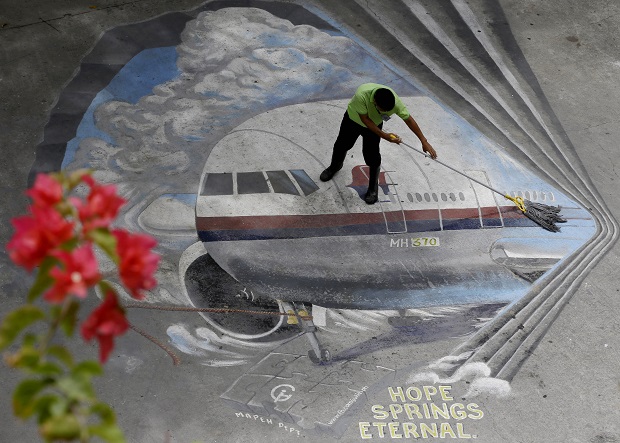Airlines symbolize nations’ hopes or reflect shame

A school utility worker mops a mural depicting the missing Malaysia Airlines Flight 370 at the Benigno “Ninoy” Aquino High School campus in Makati City. AP
NEW YORK—The jetliner is much more than a machine used to get from one spot to another. It often carries deep symbolism, especially when flying for a national airline.
It can represent hope, modernity and a country’s power. And when things go wrong it, that once mighty plane can bring about deep national disgrace.
Malaysia now finds itself grappling with the horrific — and extremely unusual — loss of two of its airplanes, just four months apart. It’s a sad coincidence that also stings.
“It is unbelievable misfortune that struck (Malaysia Airlines) in such a short span of time. It will not affect Malaysia’s name, but it will damage MAS’ reputation,” said James Chin, political analyst at Monash University in Malaysia. He said it would be tough for the loss-making airline to survive the twin catastrophes.
The shooting down of Malaysia Airlines Flight 17 on Thursday over Ukraine comes just 131 days after the disappearance of Flight 370. That Boeing 777 is presumed to be on the floor of the Indian Ocean but, without any scrap of wreckage found, it remains the key to one of the biggest aviation mysteries.
Article continues after this advertisementFair or not, the back-to-back incidents have led travelers to question the safety of flying Malaysia Airlines. Malaysian officials were widely criticized for how they handled the search for Flight 370.
Article continues after this advertisementFlying ambassadors
“Airlines symbolize the nation and are ambassadors,” says Chris Sloan, who runs the aviation history and news website Airchive.com. “Airlines tend to reflect the values of their countries.”
Even before this year’s two disasters, Malaysia Airlines had deep financial troubles, losing $370 million last year. That 6.2-percent net loss was among the worst in the global industry, according to industry newsletter Airline Weekly. Most of the world’s other airlines had a great year, posting an average profit of 4.7 percent.
“When an airline has the kind of issues that Malaysia has, it becomes a national shame,” Sloan added.
Americans have come to despise their own airlines, annoyed by invasive airport security, packed overhead bins and a lack of legroom. But in other parts of the world, the public takes great pride in national carriers.
“They like to go to the airport and see these great, glistening modern jet airplanes with the flag of their country on it,” says Robert Gandt, who spent 34 years as an airline pilot and has written 15 books including “Skygods,” an account of the demise of Pan Am.
Proclamation of colonial might
The giant pre-war route maps of European national carriers like KLM Royal Dutch Airlines and Air France were proclamations of those countries’ colonial might. The airlines often carried domineering names, like Imperial Airways, a precursor to British Airways.
“What better description is there for its purpose? It was to help keep the empire united,” says F. Robert van der Linden, chair and curator of air transportation at the Smithsonian Institution’s National Air and Space Museum.
In the 1970s, long after their empires fell, Great Britain and France teamed up to create the world’s fastest passenger jet. The supersonic Concorde wasn’t always profitable but that didn’t matter — the jet showed that the two nations were still players on the world stage.
That theme can extend to whole airlines. Italian carrier Alitalia shouldn’t even exist any longer, given its abysmal financial performance, says airline consultant George Hamlin. But the government has repeatedly bailed it out.
“That has to do with national pride, more than anything else,” Hamlin says.
That deep connection between people and their national carrier also works against an airline when somebody wishes to harm their country. For decades, the carrier El Al has been a target of anti-Israel attacks.
The United States never had a national passenger airline, but Pan Am was long considered its unofficial carrier. The airline was viewed as an extension of the US government, van der Linden says, so in countries without an American embassy or consulate, people in trouble would go to the Pan Am ticket office.
Terror attacks
That relationship is why Libyans targeted the airline in a bombing over the Scottish town of Lockerbie in 1988. Many of those killed were American college students flying home for Christmas.
The 9/11 terrorists hijacked American Airlines and United Airlines planes, in part, because of their representation of the country as a whole.
“They didn’t choose an airline that didn’t have some hint of The United States of America in its name,” van der Linden says.
It doesn’t always take a crash to stir a nation’s emotions.
Last year’s mechanical problems with the Boeing 787 Dreamliner brought embarrassment to Japan, which was proud to have engineered the plane’s electrical systems and to be the first to fly the jet.
Planes are seen as critical lifelines after a hurricane or earthquake, bringing in humanitarian workers, food, water and medical supplies. But it’s those same civilian aircraft which are used to carry troops to and from battle zones.
Tools of diplomacy
Planes used by heads of state — such as Air Force One or a jet borrowed from the national airline — also serve as tools of diplomacy and propaganda. Giant red carpet arrivals, with military bands playing, are meant to show off a country’s power.
“They are the ultimate stage props,” says Henry Harteveldt, a travel industry analyst with Atmosphere Research Group.
Ultimately, as a traveler, there’s something familiar and comforting about flying your country’s own airline, says Janet Bednarek, an aviation history professor at the University of Dayton. The flight attendants speak your language and serve your food.
“It’s that little piece of home,” she says, “that you take with you when you fly abroad.”
RELATED STORIES
Complete list of passengers of MH17
MH17 Crash: Why they were on Flight MH17